《动物免疫学》课程PPT教学课件(讲稿)抗体产生的多样性(英文)
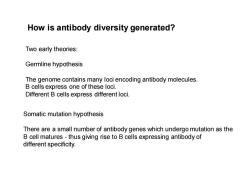
How is antibody diversity generated? Two early theories: Germline hypothesis The genome contains many loci encoding antibody molecules B cells express one of these loci. Different B cells express different loci. Somatic mutation hypothesis There are a small number of antibody genes which undergo mutation as the B cell matures -thus giving rise to B cells expressing antibody of different specificity
How is antibody diversity generated? Two early theories: Germline hypothesis The genome contains many loci encoding antibody molecules. B cells express one of these loci. Different B cells express different loci. Somatic mutation hypothesis There are a small number of antibody genes which undergo mutation as the B cell matures - thus giving rise to B cells expressing antibody of different specificity
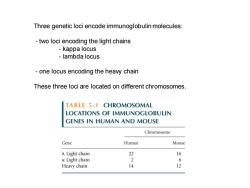
Three genetic loci encode immunoglobulin molecules: two loci encoding the light chains kappa locus lambda locus -one locus encoding the heavy chain These three loci are located on different chromosomes TABLE 5-1 CHROMOSOMAL LOCATIONS OF IMMUNOGLOBULIN GENES IN HUMAN AND MOUSE Chromosome Gene Human Mouse λLight chain 22 16 K Light chain 2 6 Heavy chain 14 12
Three genetic loci encode immunoglobulin molecules: - two loci encoding the light chains - kappa locus - lambda locus - one locus encoding the heavy chain These three loci are located on different chromosomes
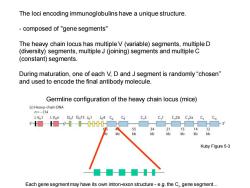
The loci encoding immunoglobulins have a unique structure. composed of "gene segments" The heavy chain locus has multiple V(variable)segments,multiple D (diversity)segments,multiple J(joining)segments and multiple C (constant)segments. During maturation,one of each V,D and J segment is randomly "chosen" and used to encode the final antibody molecule. Germline configuration of the heavy chain locus(mice) (c)Heavy-chain DNA n=-134 LVH1 LVHn DH1 DH13 JH1 JH4 Cu C Cy1 C:2b C 2a 5□…■∥…0 55 34 21 15 kb kb kb kb kb kb kb Kuby Figure 5-3 ■■■■ Each gene segment may have its own intron-exon structure-e.g.the Cu gene segment
The loci encoding immunoglobulins have a unique structure. - composed of "gene segments" The heavy chain locus has multiple V (variable) segments, multiple D (diversity) segments, multiple J (joining) segments and multiple C (constant) segments. During maturation, one of each V, D and J segment is randomly “chosen” and used to encode the final antibody molecule. Germline configuration of the heavy chain locus (mice) Each gene segment may have its own intron-exon structure - e.g. the Cm gene segment… Kuby Figure 5-3
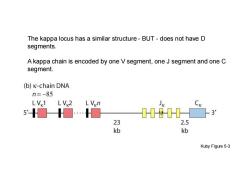
The kappa locus has a similar structure-BUT-does not have D segments A kappa chain is encoded by one V segment,one J segment and one C segment. (b)K-chain DNA n=~85 L Vx1 LVx2 LVikn ☐☐…☐ 1-1-11☐3 23 2.5 kb kb Kuby Figure 5-3
The kappa locus has a similar structure - BUT - does not have D segments. A kappa chain is encoded by one V segment, one J segment and one C segment. Kuby Figure 5-3
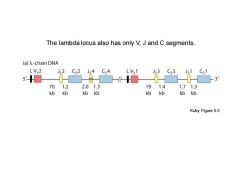
The lambda locus also has only V,J and C segments. (a)λ-chain DNA 。1 LV2 2 C22 J4 C4 LVx1 J3 Cx3 J1 Cx1 701.22.01.3 191.4 1.71.3 kbkbkbkb kbkb kbkb Kuby Figure 5-3
The lambda locus also has only V, J and C segments. Kuby Figure 5-3
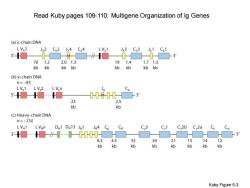
Read Kuby pages 109-110:Multigene Organization of Ig Genes (a)A-chain DNA LV22 Jx2 Cx2 J4 C24 LVx1 Jx3 Cx3 J1 C.1 5☐ 701.2 2.01.3 191.41.713 kbkb kbkb kbkb kbkb (b)K-chain DNA n=-85 LV1 LV 2 LVen (4 ☐☐… 1-181☐3 23 2.5 kb kb (c)Heavy-chain DNA n=-134 LVH1 LVHn DH1 DH13 JH1 JH4 Cu C8 C3 C,1 C 2b Cy2a Ce ☐…a∥-…H☐ -3 6.54.5 55 34 21 15 14 12 kbkb kb kb kb kbkb kb Kuby Figure 5-3
Read Kuby pages 109-110: Multigene Organization of Ig Genes Kuby Figure 5-3
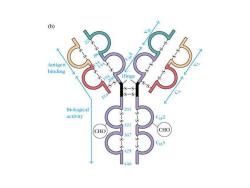
(b) Antigen binding Biological activity CHO CHO 6
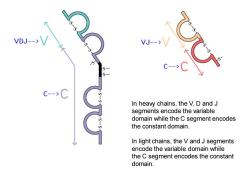
VDJ--> W- C-- c-->C In heavy chains,the V,D and J segments encode the variable domain while the C segment encodes the constant domain. In light chains,the V and J segments encode the variable domain while the C segment encodes the constant domain
In heavy chains, the V, D and J segments encode the variable domain while the C segment encodes the constant domain. In light chains, the V and J segments encode the variable domain while the C segment encodes the constant domain
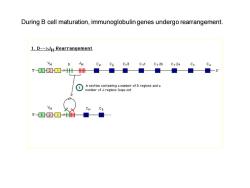
During B cell maturation,immunoglobulin genes undergo rearrangement. 1.D-->JH Rearrangement H D JH Cy3 Cy1 Cy2b Cy2a Ca 5'32☒什H州■■■ -3 A section containing a number of D regions and a number of Jregions loops out H Cs 5'☒2☒☐中H册
During B cell maturation, immunoglobulin genes undergo rearrangement
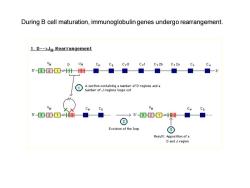
During B cell maturation,immunoglobulin genes undergo rearrangement. 1.D-->JH Rearrangement D JH Cμ Cs Cy3 Cy1 Cy2b Cy2a 5'32☒什州■■■ A section containing a number of D regions and a number of J regions loops out Cμ Cμ 5'3☒2☒□HH州 5'☒2☒HHH Excision of the loop Result:Apposition of a D and J region
During B cell maturation, immunoglobulin genes undergo rearrangement
按次数下载不扣除下载券;
注册用户24小时内重复下载只扣除一次;
顺序:VIP每日次数-->可用次数-->下载券;
- 《动物免疫学》课程PPT教学课件(讲稿)抗体-抗原反应(Antibody-Antigen Reactions).ppt
- 《动物免疫学》课程PPT教学课件(讲稿)抗原(Antigen, Ag).ppt
- 《动物免疫学》课程PPT教学课件(讲稿)免疫自动化仪器分析.ppt
- 《动物免疫学》课程PPT教学课件(讲稿)免疫耐受 Immunological Tolerance.ppt
- 《动物免疫学》课程PPT教学课件(讲稿)免疫系统的遗传学(Genetics of the Immune system).ppt
- 《动物免疫学》课程PPT教学课件(讲稿)免疫系统(The Immune System).ppt
- 《动物免疫学》课程PPT教学课件(讲稿)免疫球蛋白(Immunoglobulin, Ig).ppt
- 《动物免疫学》课程PPT教学课件(讲稿)免疫标记技术及应用.ppt
- 《动物免疫学》课程PPT教学课件(讲稿)免疫应答概述(Immune response).ppt
- 《动物免疫学》课程PPT教学课件(讲稿)免疫学概论.ppt
- 《动物免疫学》课程PPT教学课件(讲稿)免疫学发展简史及展望.ppt
- 《动物免疫学》课程PPT教学课件(讲稿)体液免疫反应 Humoral Immune Response.ppt
- 《动物免疫学》课程PPT教学课件(讲稿)传染与免疫(病原体对机体的感染、机体对感染的预防和治疗).ppt
- 《动物免疫学》课程PPT教学课件(讲稿)主要组织相容性抗原系统(histicompatibility antigen).ppt
- 《动物免疫学》课程PPT教学课件(讲稿)主要组织相容性复合体及其编码分子.ppt
- 《动物免疫学》课程PPT教学课件(讲稿)主要的补体系统缺乏(Primary deficiencies of the complement system).ppt
- 《动物免疫学》课程PPT教学课件(讲稿)T淋巴细胞与特异性细胞免疫.ppt
- 《动物免疫学》课程PPT教学课件(讲稿)Cellular Cooperation and Antigen Recognition.ppt
- 《动物免疫学》课程PPT教学课件(讲稿)IL-8生物活性的检测.ppt
- 《动物免疫学》课程PPT教学课件(讲稿)细胞因子 Cytokines.ppt
- 《动物免疫学》课程PPT教学课件(讲稿)抗原、受体和球蛋白 Antigens, Receptors and Immunoglobulins.ppt
- 西南民族大学:《动物免疫学》课程PPT教学课件(讲稿)抗原抗体反应 antigen-antibody reaction(主讲:岳华).ppt
- 《动物免疫学》课程PPT教学课件(讲稿)B淋巴细胞与特异性体液免疫.ppt
- 《动物免疫学》课程PPT教学课件(讲稿)淋巴细胞抗原识别受体的编码及多样性的产生.ppt
- 《动物免疫学》课程PPT教学课件(讲稿)白细胞分化抗原和黏附分子.ppt
- 《动物免疫学》课程PPT教学课件(讲稿)补体系统(激活、调节、生物学作用).ppt
- 《动物免疫学》课程PPT教学课件(讲稿)补体系统和细胞因子.ppt
- 《动物免疫学》课程PPT教学课件(讲稿)补体系统(The Complement System).ppt
- 《动物免疫学》课程PPT教学课件(讲稿)超敏反应(1)Hypersensitivity Reactions.ppt
- 《动物免疫学》课程PPT教学课件(讲稿)超敏反应 Hypersensitivity.ppt
- 《动物免疫学》课程PPT教学课件(讲稿)超敏反应(2-5型)Hypersensitivity Types II-V.ppt
- 《动物免疫学》课程PPT教学课件(讲稿)非特异性免疫的组成细胞及功能.ppt
- 广东海洋大学:《动物繁殖学》课程教学大纲 Animal Reproduction(打印版).pdf
- 广东海洋大学:《动物繁殖学》课程教学课件(PPT讲稿)第一章 绪论 Animal Reproduction(负责人:安立龙).ppt
- 广东海洋大学:《动物繁殖学》课程授课教案(打印版,主讲:安立龙、巨向红).pdf
- 广东海洋大学:《动物繁殖学》课程教学课件(PPT讲稿)第三章 动物生殖激素及其作用.ppt
- 广东海洋大学:《动物繁殖学》课程教学课件(PPT讲稿)第九章 动物胚胎工程.ppt
- 广东海洋大学:《动物繁殖学》课程教学课件(PPT讲稿)第二章 家畜的生殖器官.ppt
- 广东海洋大学:《动物繁殖学》课程教学课件(PPT讲稿)第五章 雌性动物的发情(母畜的生殖生理).ppt
- 广东海洋大学:《动物繁殖学》课程教学课件(PPT讲稿)第六章 受精、妊娠、分娩.ppt
